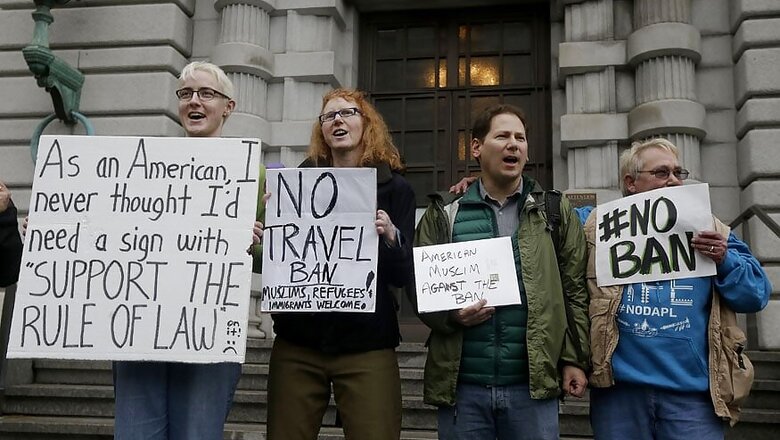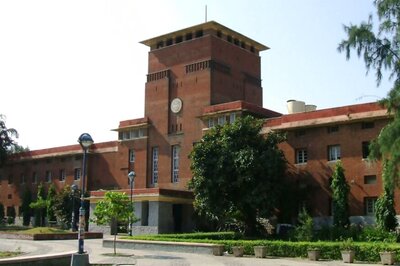
views
Washington: The Supreme Court upheld the constitutionality of the latest version of President Donald Trump's travel ban Tuesday, holding that the President was within his authority when he blocked travel from several countries, most of which are predominantly Muslim.
Here's a look at everything that's happened over the last 18 months that has led up to Tuesday's Supreme Court decision.
December 7, 2015: The Trump campaign news release
Trump, then a Republican presidential front-runner, called for banning all Muslims from entering the United States.
"Donald J. Trump is calling for a total and complete shutdown of Muslims entering the United States until our country's representatives can figure out what is going on," a news release from his campaign said.
The release came in wake of the mass shooting in San Bernardino, California, which left 14 people dead.
Many of his supporters showed their approval on social media. However, others in Washington — including members of the GOP — were not as pleased.
Trump's proposal is "not who we are as a party" and violates the Constitution, House Speaker Paul Ryan said at the time.
May 2016: Muslim ban 'just a suggestion'
Later while campaigning, Trump noted the ban was "just a suggestion."
"We have a serious problem, and it's a temporary ban — it hasn't been called for yet, nobody's done it, this is just a suggestion until we find out what's going on," he told Fox News' Brian Kilmeade.
Earlier that same month, Trump emphasized the temporary nature of the ban.
"No, it was never meant to be — I mean that's why it was temporary," he told Fox News' Greta Van Susteren, when asked if he would consider backing off the controversial ban.
January 27, 2017: Trump signs executive order
Fast forward to Trump's first month in the White House.
As President, Trump issued an executive order banning entry for 90 days by citizens from seven Muslim-majority countries: Iraq, Syria, Iran, Libya, Somalia, Sudan and Yemen. The order also indefinitely halted refugees from Syria.
Trump also stopped the admission of all refugees to the United States for four months.
The order also called for a review into suspending the Visa Interview Waiver Program, which allows travelers from 38 countries — including close allies — to renew travel authorizations without an in-person interview.
January 27 - 31, 2017: The aftermath of the initial ban
Mass protests erupted at airports across the United States in opposition to the travel ban.
Then courts began weighing in, with judges in New York and Massachusetts temporarily blocking parts of the order.
US Judge Ann M. Donnelly held that the petitioners had a "strong likelihood of success" in establishing that their removal "violates their rights to Due Process and Equal Protection guaranteed by the United States Constitution."
A federal judge in Massachusetts blocked a part of the order in a case brought by lawyers for two lawful permanent residents who are college professors. That order went a step further ordering that the government could not "detain or remove" those who arrived legally from the seven countries subject to Trump's order.
Meanwhile, the White House continued to defend the order, despite backlash from some lawmakers (Senate Republicans squashed two moves by Democrats, including an attempt to begin debating a bill that would rescind the executive order).
After acting Attorney General Sally Yates declined to defend the travel ban, Trump fired her.
February 2017: Appeals court takes on ban
US District Court Judge James Robart on February 3 blocked the ban nationwide.
On February 5, a federal appeals court rejected the US government's emergency request to resume the ban. The Ninth Circuit Court of Appeals in San Francisco asked both sides to file legal briefs before the court makes it final decision.
This led to arguments being presented in the Ninth Court of Appeals, as three judges grilled lawyers from the Justice Department and Washington state. A three-judge panel ruled against reinstating the ban. The President's top policy aide, Stephen Miller, said the administration was "considering and pursuing all options."
March 2017: A revised travel ban is unveiled — and is again blocked
Six weeks after the original executive order was unveiled, Trump announced a new version of the travel ban, which he later deemed a "watered-down version" of the first order.
This time, the ban excluded Iraq from the list of Muslim-majority countries whose citizens were temporarily blocked. It also barred foreign nationals from Iran, Libya, Somalia, Sudan, Syria and Yemen from entering the United States for 90 days and all refugees for 120 days.
It was set to take effect on March 16.
Attorneys for Hawaii filed the first lawsuit against the new travel ban — and on March 15, US District Court Judge Derrick Watson in Hawaii blocked the President's new travel ban hours before it was set to begin. The temporary restraining order applied nationwide.
The President said the decision was "an unprecedented judicial overreach."
That same month, on March 16, US District Judge Theodore Chuang in Maryland specifically blocked the 90-day ban on immigration for citizens of the six Muslim-majority countries.
Chuang and Watson both cited Trump's statements about Muslims during the presidential campaign as part of their rulings.
May 2017: The 4th Circuit Court of Appeals heard the challenge
The 4th Circuit Court of Appeals heard the challenge to a Maryland judge's decision to freeze the revised ban on May 8.
Later that month, the appeals court ruled 9-4 against the ban, holding that it "continues to exhibit a primarily religious anti-Muslim objective."
June 2017: Supreme Court partially upholds travel ban
In mid-June, the Ninth Circuit court dealt the Trump travel ban another defeat, affirming a Hawaii judge's ruling that blocked the ban. Like other courts, the Ninth Circuit cited Trump's tweets against the administration's case on the travel ban.
But later in the month, the Supreme Court allowed part of the travel ban to take effect.
In its decision to partially greenlight the ban, the Supreme Court said foreigners from six majority-Muslim countries must now have a "bona fide" relationship to a person or entity to enter the US.
The new guidelines said applicants must prove their relationship to a parent, spouse, child, adult son or daughter, son-in-law, daughter-in-law or sibling in the US in order to enter the country.
Others — including grandparents — would not be considered "close family."
4:47 AM - Jun 4, 2017
Trump tweeted a total of six times about the ban in June, beginning with a June 3 tweet saying the travel ban is needed "as an extra level of safety."
A few days later, he weighed in on people calling the travel ban a "Muslim ban." "People, the lawyers and the courts can call it whatever they want, but I am calling it what we need and what it is, a TRAVEL BAN!" he tweeted on June 5.
He also said the Justice Department "should have stayed with the original Travel Ban, not the watered down, politically correct version they submitted to S.C."
September 2017: Travel ban 3.0
The Trump administration unveiled new travel restrictions on certain foreigners from Chad, Iran, Libya, North Korea, Somalia, Syria, Venezuela and Yemen as a replacement to a key portion of the previous bans.
The new restrictions on travel varied by country and include a phased-in approach.
The new list of countries notably included two non-Muslim majority nations, including North Korea and Venezuela. In most instances, travel would be broadly suspended, while in other cases, travelers will have to undergo enhanced screening and vetting requirements.
December 2017: Supreme Court lets travel ban take effect
The Supreme Court allowed the newest version of the ban to take effect pending appeal. This is the first time justices had allowed any edition of the ban to go forward in its entirety.
Only Justices Ruth Bader Ginsburg and Sonia Sotomayor dissented.
On December 22, a three-judge panel of the 9th US Circuit Court of Appeals ruled that the ban violates federal law. The three judges, all nominees of President Bill Clinton, said the travel ban exceeds the President's authority.
January 2018: Supreme Court agrees to hear oral arguments
The Supreme Court said that it would take up a challenge to the latest version of the travel ban in April.
April 25, 2018: Oral arguments
The Supreme Court heard oral arguments on the travel ban.
The Trump administration argued forcefully in favor of the travel ban, with Solicitor General Noel Francisco emphasizing "this is not a so-called 'Muslim ban."
Coming out of oral arguments, the Supreme Court justices wrestled with the travel ban, at times breaking down on ideological lines.
Justice Anthony Kennedy expressed some reservation about a candidate's expressions of animus against Muslims during the campaign, but didn't seem to have overall concerns about the President's authority to ban entry, noting that the travel ban could be reviewed every 180 days.
Other justices, including Chief Justice John Roberts and Samuel Alito, also highlighted the President's power in this area.



















Comments
0 comment